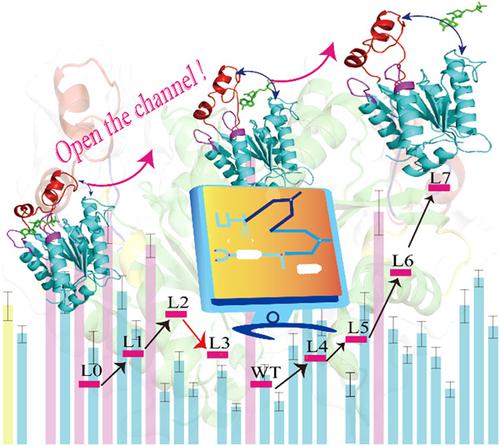当前位置:
X-MOL 学术
›
Biotechnol. Bioeng.
›
论文详情
Our official English website, www.x-mol.net, welcomes your
feedback! (Note: you will need to create a separate account there.)
Rational design of a highly efficient catalytic system for the production of PAPS from ATP and its application in the synthesis of chondroitin sulfate
Biotechnology and Bioengineering ( IF 3.5 ) Pub Date : 2021-08-18 , DOI: 10.1002/bit.27919 Kaifang Liu 1, 2, 3 , Xiulai Chen 1, 2, 3 , Yunlu Zhong 1, 2, 3 , Cong Gao 1, 2, 3 , Guipeng Hu 3, 4 , Jia Liu 1, 2, 3 , Liang Guo 1, 2, 3 , Wei Song 3, 4 , Liming Liu 1, 2, 3
Biotechnology and Bioengineering ( IF 3.5 ) Pub Date : 2021-08-18 , DOI: 10.1002/bit.27919 Kaifang Liu 1, 2, 3 , Xiulai Chen 1, 2, 3 , Yunlu Zhong 1, 2, 3 , Cong Gao 1, 2, 3 , Guipeng Hu 3, 4 , Jia Liu 1, 2, 3 , Liang Guo 1, 2, 3 , Wei Song 3, 4 , Liming Liu 1, 2, 3
Affiliation

|
The compound 3′-phosphoadenosine-5′-phosphosulfate (PAPS) serves as a sulfate group donor in the production of valuable sulfated compounds. However, elevated costs and low conversion efficiency limit the industrial applicability of PAPS. Here, we designed and constructed an efficient and controllable catalytic system for the conversion of adenosine triphosphate (ATP) (disodium salt) into PAPS without inhibition from by-products. In vitro and in vivo testing in Escherichia coli identified adenosine-5′-phosphosulfate kinase from Penicillium chrysogenum (PcAPSK) as the rate-limiting enzyme. Based on analysis of the catalytic steps and molecular dynamics simulations, a mechanism-guided “ADP expulsion” strategy was developed to generate an improved PcAPSK variant (L7), with a specific activity of 48.94 U·mg−1 and 73.27-fold higher catalytic efficiency (kcat/Km) that of the wild-type enzyme. The improvement was attained chiefly by reducing the ADP-binding affinity of PcAPSK, as well as by changing the enzyme's flexibility and lid structure to a more open conformation. By introducing PcAPSK L7 in an in vivo catalytic system, 73.59 mM (37.32 g·L−1) PAPS was produced from 150 mM ATP in 18.5 h using a 3-L bioreactor, and achieved titer is the highest reported to date and corresponds to a 98.13% conversion rate. Then, the PAPS catalytic system was combined with the chondroitin 4-sulfotransferase using a one-pot method. Finally, chondroitin sulfate was transformed from chondroitin at a conversion rate of 98.75%. This strategy has great potential for scale biosynthesis of PAPS and chondroitin sulfate.
中文翻译:

ATP制备PAPS高效催化体系的合理设计及其在硫酸软骨素合成中的应用
化合物 3'-phosphoadenosine-5'-phosphosulfate (PAPS) 在有价值的硫酸化化合物的生产中充当硫酸基供体。然而,高成本和低转换效率限制了 PAPS 的工业适用性。在这里,我们设计并构建了一个高效且可控的催化系统,用于将三磷酸腺苷 (ATP)(二钠盐)转化为 PAPS,而不受副产物的抑制。在大肠杆菌中进行的体外和体内测试确定了产黄青霉( Pc APSK) 中的腺苷 5'-磷酸硫酸酯激酶是限速酶。在分析催化步骤和分子动力学模拟的基础上,开发了一种机制引导的“ADP 排斥”策略,以产生改进的PcAPSK变体(L7),比活性为48.94 U·mg -1 ,催化效率( kcat / Km)是野生型酶的73.27倍。改进主要是通过降低Pc APSK 的 ADP 结合亲和力,以及通过将酶的灵活性和盖子结构改变为更开放的构象来实现的。通过在体内催化系统中引入Pc APSK L7,73.59 mM (37.32 g·L -1) PAPS 是使用 3-L 生物反应器在 18.5 小时内从 150 mM ATP 生产的,达到的滴度是迄今为止报道的最高滴度,对应于 98.13% 的转化率。然后,使用一锅法将 PAPS 催化体系与软骨素 4-磺基转移酶结合。最后,硫酸软骨素以98.75%的转化率由软骨素转化而来。该策略在 PAPS 和硫酸软骨素的规模生物合成方面具有巨大潜力。
更新日期:2021-10-13
中文翻译:

ATP制备PAPS高效催化体系的合理设计及其在硫酸软骨素合成中的应用
化合物 3'-phosphoadenosine-5'-phosphosulfate (PAPS) 在有价值的硫酸化化合物的生产中充当硫酸基供体。然而,高成本和低转换效率限制了 PAPS 的工业适用性。在这里,我们设计并构建了一个高效且可控的催化系统,用于将三磷酸腺苷 (ATP)(二钠盐)转化为 PAPS,而不受副产物的抑制。在大肠杆菌中进行的体外和体内测试确定了产黄青霉( Pc APSK) 中的腺苷 5'-磷酸硫酸酯激酶是限速酶。在分析催化步骤和分子动力学模拟的基础上,开发了一种机制引导的“ADP 排斥”策略,以产生改进的PcAPSK变体(L7),比活性为48.94 U·mg -1 ,催化效率( kcat / Km)是野生型酶的73.27倍。改进主要是通过降低Pc APSK 的 ADP 结合亲和力,以及通过将酶的灵活性和盖子结构改变为更开放的构象来实现的。通过在体内催化系统中引入Pc APSK L7,73.59 mM (37.32 g·L -1) PAPS 是使用 3-L 生物反应器在 18.5 小时内从 150 mM ATP 生产的,达到的滴度是迄今为止报道的最高滴度,对应于 98.13% 的转化率。然后,使用一锅法将 PAPS 催化体系与软骨素 4-磺基转移酶结合。最后,硫酸软骨素以98.75%的转化率由软骨素转化而来。该策略在 PAPS 和硫酸软骨素的规模生物合成方面具有巨大潜力。









































 京公网安备 11010802027423号
京公网安备 11010802027423号